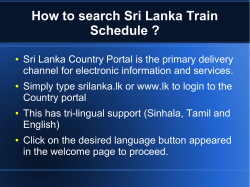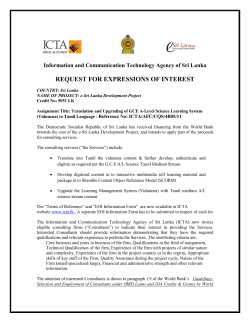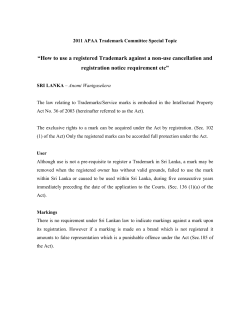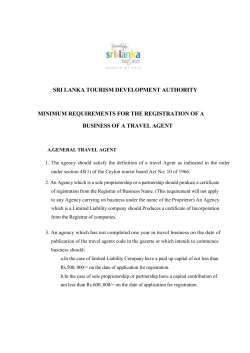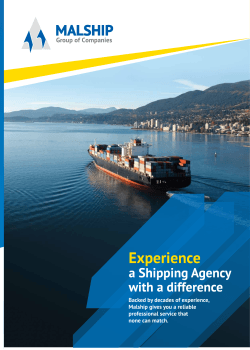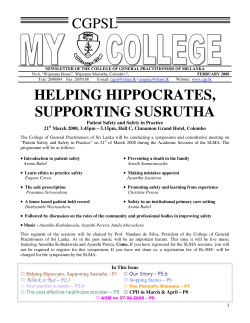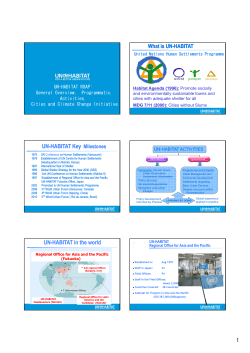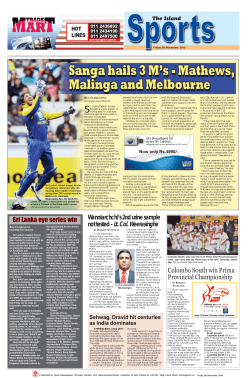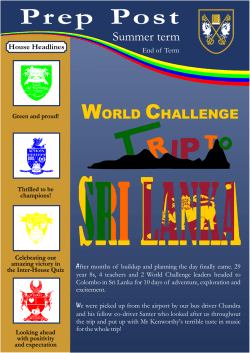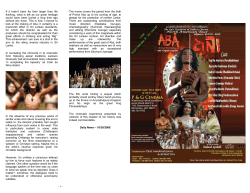
Cover Sheet Teacher-Developed Classroom Units and Assessments ✔
Cover Sheet Teacher-Developed Classroom Units and Assessments ___Unit ___Assessment ✔ Kathryn "Gussie" Wyndham, Cherry Creek High School, Cherry AUTHOR(S): _________________________________________ Creek 5 School District _____________________________________________________ _____________________________________________________ _____________________________________________________ _____________________________________________________ International Trade: Creating a Product for a Global Market TITLE:______________________________________________ _____________________________________________________ _____________________________________________________ Geography 4.3; Geography 5.3; Geography 1.1 SUBJECT AREA(S):___________________________________ _____________________________________________________ _____________________________________________________ _____________________________________________________ Secondary, 11th Grade GRADE LEVEL/AUDIENCE:___________________________ _____________________________________________________ _____________________________________________________ 1999 DATE:_______________________________________________ Staff of the History, Geography, Civics Summer Institute and REVIEWED BY:______________________________________ the Colorado Department of Education. _____________________________________________________ _____________________________________________________ 1999 Written by Kathryn Wyndham COPYRIGHT INFORMATION: ©_______________________ _____________________________________________________ _____________________________________________________ This material may be reproduced for classroom use. Colorado Department of Education Standards & Assessment Resource Bank Geography Assessment 11th Grade International Trade: Creating a Product for a Global Market Kathryn “Gussie” Wyndham, Cherry Creek School District Inquiry Question: Standards assessed: Geography 4.3 How does economic interdependence and cooperation between nations affect countries, companies’ decisions, and the environment through global trade? Students understand the patterns and networks of economic interdependence. • Analyzing factors influencing economic interdependence of countries, including world trade. • Analyzing connections among local, regional, and world economies. Geography 5.3 Students understand the changes that occur in the meaning use, location, distribution, and importance of resources. • Analyzing the effects of economic activity in modifying and transforming the environment, Geography 1.1 Students know how to use maps, globes, and other geographic tools to acquire, process, and report information from spatial perspective. • Interpreting maps and other tools, through the analysis of case studies and using data. Overview: Through the process of evaluating proposals and writing an Executive Summary, students demonstrate their understanding that global trade is a vehicle which results in interconnectedness and cooperation among countries, people and the environment. The assessment scenario is as follows: A company with capital to invest in the development of a manufactured product on the international market has taken the initial steps to procure the perfect site and conditions to expand. The student is an evaluator for this proposed venture. Directed by the CEO, the student will evaluate three proposals that have been submitted by research teams. The student must focus on market targets, plausible marketing techniques, trade alliances/treaties, resources available (both domestic and international), environmental impacts and how, where, and by whom the product will be produced. The student will have access to handouts that include: three product proposals, directions for completing an Executive Summary, and a scoring guide. Materials Needed: Handout #1: Instructions for Executive Summary Handout #2: Blank world map Handout #3: Blank planning chart Handouts #4, 5, 6: Proposals for Venezuela, Taiwan, and Sri Lanka Handout #7: Scoring Guide Optional: Maps of the three countries under consideration Student World Almanacs Time Allotment: Prior Learning: One class period and homework Prior learning could include: • Development of geographic skills on using and interpreting maps, atlases and almanacs. • Understanding the concept of international interconnectedness. • Defining the term “system” and understanding that the earth operates as huge system of interrelated subsystems. • Demonstrating understanding of change and cross-cultural communication. • Identifying resources and the environmental tradeoffs. • Understanding growing regional cooperation. • Identifying various treaties and trade alliances. Teacher Instructions: Day One Pose the question: How does economic interdependence and cooperation between nations affect countries, companies’ decisions, and the environment through global trade? Distribute Student Handout #1. Read aloud and check for understanding. Distribute Student Handouts #2 - 7. Monitor the room as students complete their charts and/or maps. The chart and/or map will assist students as they write their Executive Summaries. You may also wish to distribute maps of the three nations that are under review as well as almanacs. Explain that the Executive Summary will be finalized at home and returned at the beginning of class the next day. (Homework) Day Two Collect Executive Summary and debrief assessment, if desired. Handout # 1 Creating a Product for a Global Market You have been hired by a company that has capital to invest in the development of a new manufactured product for the international market. You are an evaluator who must help the company determine which of the proposed enterprises will be the best choice for their investment. You must evaluate three proposals that have been submitted and make a final recommendation to the CEO (Chief Executive Officer) via an Executive Summary, a brief 1-2 page report in defense of the best proposal. You must select one of the three proposals. Your critique is important and must be concise. The Executive Summary should be thorough, 1-2 pages in length, typed, and ready for the CEO tomorrow. Remember: only ONE proposal may be selected! The three selections for your consideration are on Student Handouts #4, 5 and 6. In writing your Executive Summary, be sure to consider: • the target markets • plausible marketing techniques • trade alliance/treaties • resources available in country of origin • resources needed from the international trade market • environmental impact, and • the how, where, and by whom the product will be produced. Which one will you recommend to the CEO? The Executive Summary must have rationale for all areas as the CEO does not have time to check your worksheets. Millions of dollars are awaiting your expert decision. Use Student Handout #2 (blank world map) and Student Handout #3 (blank chart) to help you organize your thoughts. Student Handout #7 is a scoring guide. The CEO will accept your Executive Summary in 24 hours! Handout #3: Chart Country Product Imports/ Where Market(s) Environment How/Where/ Whom Marketing Techniques Trade/ Treaties Resources available Handout #4 Proposal for Venezuela Product: Individual coffee bags Venezuela has the resource of coffee, a necessary commodity to make individual coffee bags or packets. The best quality coffee comes from plantations in the mountains. Cuba has paper products for export. Chile has paper products. Germany has the materials and machinery for printing and the production of ink. Possible target markets could include Canada, Germany, and/or the Netherlands. The countries targeted for marketing are located in climate zones where it is impossible to produce coffee; the countries mentioned are filled with workers who need that first cup of the day! Venezuela is a 1/3 larger than Texas, occupying most of the northern coast of South America on the Caribbean Sea. Columbia borders it to the west, Guyana to the east, and Brazil to the south. Mountain systems break Venezuela into four distinct areas: (1) the Maracaibo lowlands, (2) the mountainous region in the north and northwest, (3) the Orinoco basin, with grass covered plains on the south and southeast, (4) the Guiana Highlands, accounting for nearly half of the national territory. Languages: Spanish, Indian dialects in the interior. Literacy rates: 90% Agricultural products: rice, coffee, corn, cacao, sugar, bananas, dairy and meat products Labor force: 7.6 million, 63% in services, and 25% in industry Principle industrial products: refined petroleum products, aluminum, iron, steel, cement, textiles, and transport equipment Natural resources: petroleum, natural gas, iron ore, and hydroelectric power Major trading partners: United States, Japan, Germany, Italy, Netherlands, Canada Additional data on Venezuela: • One of the most stable political systems in South America; since 1958 all governments have been civilian and democratically elected. • The country has vast petroleum reserves. Petroleum is a necessary item in the production of plastic. • The government has introduced a package of austerity and trade restructuring measures to contain inflation, make industry more competitive, and refinance the foreign debt. • Labor costs are a sizable element in production costs. The following are organizations and various affiliations for Venezuela: • Andean Group -- Five country membership. Regional cooperation including development finance. Started in 1969. • OPEC- Organization of Petroleum Exporting Countries. 13 members established in 1960. Coordinates crude oil export price levels. Fund for aid to develop countries. • United Nations • OAS - Organization of American States. Established on 1948. Presently has 35 members. US and almost all South and Central America. Peace, security, mutual understanding and cooperation among states of Western Hemisphere are the major concerns. Handout #5 Proposal for Taiwan Product : Remote control car Taiwan has the technical expertise to build the electronics necessary for the great toy. Metals would be required; Germany has iron ore, coal, copper, and nickel. Saudi Arabia has petroleum in excess. It should be noted that petroleum is essential in the production of plastics. Possible markets for the remote control car could be the United States, Canada, New Zealand, and Australia. These industrialized countries have the extra dollars to buy expensive but neat toys. Leisure time has increased and the “kid in all of us” needs toys. The appeal would be across the ages and for both genders. The Republic of China consists of the island of Taiwan, an island 100 miles off the Asian mainland in the Pacific; two offshore islands Kinmen and Matsu; and the nearby islets of the Pescadores chain. It is slightly larger than the combined areas of Massachusetts and Connecticut. Taiwan is divided by a central mountain range that runs north and south, sharply ascending on the east coast and descending gradually to a broad western plain, where cultivation is concentrated. Taiwan became the seat of China’s Nationalists government following the 1945-50 civil war when the Chinese Communists established the People’s Republic of China on the mainland. In 1971, when the People’s Republic was admitted to the United Nations, Taiwan lost its seat in the organization, its legitimacy no longer recognized. The central government consists of five major branches: Executive, Legislative, Judicial, Control, and Examination. President and Vice President are popularly elected for a term of four years. Languages: Chinese (Mandarin) Literacy rate: 93% Principle products: rice, yams, sugar cane, bananas, pineapples, and citrus fruits Labor force: 9,270,000 ; 39% in industry, 11.5% in agriculture, and 49.4% in services Natural resources: coal, natural gas, limestone, and marble Major trading partners: United States, Japan, and Germany Additional information about Taiwan: • Work force has a positive attitude toward foreign employers and is educated and skilled • The export market is very successful • Large foreign currency reserves are established, and there is minimal foreign debt and low inflation • There is good potential in the service and technology industries • Factories and plants must meet environmental protection standards • Highway and railway networks are extensive • The normal workweek is 48 hours • The national health insurance and labor insurance schemes require employers’ contribution • Many employers provide their workers with free dormitory accommodations or a meal allowance • Half of the country’s electricity is generated from fossil fuel (must be imported) Taiwan is a member of SEATO -- South East Asian Treaty Organization: formed by collective defense pact signed in Manila by the U.S. , Britain, France , Australia, New Zealand, Philippines, Pakistan, and Thailand. Handout #6 Proposal for Sri Lanka Product: Pencils Sri Lanka has the resource graphite, a necessary commodity to make pencils. The nation of Indonesia has timber to export and Thailand has ample tin and rubber for our needs. The team recommends the possible target markets of Japan and the United States. Possible methods of marketing include handing out free sample pencils at teacher conferences to encourage brand recognition and product loyalty. The choice of Japan as one of the markets is based on the student school schedules. Not only do the Japanese students have a 220-day school year but most attend night schools to enable them to score well on university entrance exams. Sri Lanka is an island in the Indian Ocean off the southeastern tip of India. Sri Lanka is about half the size of Alabama. Most of the land is flat and rolling; mountains in the south central region rise to over 8,000 feet. Ceylon became an independent country in 1948 after British rule and reverted to the traditional name Sri Lanka (“Resplendent Island”) on May 22, 1972. A new constitution was adopted in 1978 and set up the National State Assembly, a 225-member unicameral legislature that serves for six-year terms unless dissolved earlier. Sri Lanka became a self-governing dominion of the Common Wealth of Nations in 1948. Principle products: tea, coconuts, rubber, rice, and spices Labor force: 6,600,000, 13% in mining and manufacturing Literacy rate: 90% Natural resources include: limestone, graphite, and gems Major trading partners: United States, United Kingdom, Germany, Japan, Singapore, India, Taiwan, Belgium, and China Languages: Sinhala, Tamil, and English Additional information about Sri Lanka: • Skilled manpower and professional managers are available at moderate cost • Strategic location from which to access the South Asian markets • The use of foreign brand names is permitted • Safety, environment, and consumer protection controls are being made extensive • As factor of production, labor costs compare favorably with those of industrialized countries • Provisions of pension or provident fund schemes are not mandatory The following are organizations and various affiliations for Sri Lanka: • • • • • • Non-Aligned Movement - association of countries outside super blocks. Program for economic and technical cooperation. Additional focus, since 1992, the environment. 104 nation membership. Colombo Plan - seven neighboring nations for economic growth. SARC - South Asia Regional Cooperation Committee. Group 77 - membership now includes over 120 nations but retains old name. Principal comprehensive Third World voice on economic matters. United Nations British Commonwealth - Commonwealth nations were once British colonies but have special trading arrangements with each other. Student Handout #7: Scoring Guide Standard 4.3: Student understands patterns and networks of economic interdependence Standard 5.3: Student understands the changes in the meaning, use, location, distribution and importance of resources Standard 1.1: Student knows how to use geographic tools to acquire and report spatial information Advanced: 4 points Executive Summary is well written and clearly defends one proposal. It is concise, professional and convincing. Response: • emphasizes importance of trade agreements, relationships, and partners • explains marketing techniques appropriate for chosen markets • discusses import/export potential • provides thorough list of resources available (including labor force, raw materials) • clearly explains environmental issues and includes possible recommendations for restoration • addresses sustainability • provides thoughtful analysis and plausible conclusions based on data • locates reasonable potential site for factory, based on data • considers trade routes and/or ease of transport based on maps Proficient: 3 points Executive Summary is clear and defends one proposal. Basic: 2 points Executive Summary is somewhat vague and provides limited support for the selected proposal. Response: • simply lists a few trading partners • mentions unsuitable marketing strategies Limited: 1 point Executive Summary is vague and does not adequately support any proposal. Response: • does not mention trade partners or agreements • does not include appropriate marketing strategies includes important relevant resources discusses environmental impact, but may not mention possibilities for how to deal with it • lists a few resources (may mention raw materials but omit labor force) may mention environment, but no specific impacts • provides reasonable conclusions based on data demonstrates use of maps in site location or trade routes • reaches a conclusion that is not necessarily based on the data provided does not locate appropriate site or mention trade routes • Response: • considers importance of trading partners and trade alliances • mentions marketing strategies suitable for selected market • • • • • • • • lists resources that are wrong, irrelevant, or none at all omits environmental impact reaches no clear conclusion shows no evidence of map use (Exemplary Response. Note: all proposals could be supported) Buckeye International September 12, 1998 Economic Evaluator Department 399940 Wealthy Blvd. Bakersfield, California. 93308-7889 Dear CEO: After thoroughly examining all three proposals, I strongly recommend the Sri Lanka site as our next successful financial venture. The pencil factory would be set up on the eastern coast of the island nation, to best take advantage of the shipping lanes and reduce transportation cost with Sri Lanka. The workers would be made up of the 13% labor force trained in manufacturing. Skilled manpower and professional managers are available at a moderate cost to the company. Further, the labor costs are low compared to the other proposals. Sri Lanka’s natural resources of graphite and timber would be augmented with timber from Indonesia. The trade relationship is strong between these two nations, via SARC, the Non-Aligned Movement and the Colombo Plan. All these agreements are dedicated to strengthening trade in South Asia and other third world nations. Rubber and tin would be commodities that would be needed in the production of the pencils. The neighboring nation of Thailand has both rubber and tin. The trade relationship between Sri Lanka and Thailand is fairly strong, again referring to organizations mentioned earlier. In addition, all three nations involved are similar and business dealings with the United States continues to be strong. The environmental impact would be sizable. The mining necessary for graphite and the production of tin would deem land reclamation necessary in Sri Lanka and Thailand. Environmental concerns growing in Sri Lanka , so this issue can not be swept under the mat. The timber needed for this project would require replanting projects in Indonesia and Sri Lanka. Indonesia would be a back up source if Sri Lanka’s government would stop the tree harvesting. Additional concerns would include the waste products from the factory and the packaging pollution. Even though the environmental concerns are great the strength of the entire proposal provides the impetus for a “GO” on this project. The marketing selection for the pencil proposal are great! Japan and the United States are strong trading partners with Sri Lanka. The marketing technique of free handouts to American educators to develop product loyalty is a wonderful possibility. Certainly, that would be a positive move for the PR department to explore. The Japanese student connection is a brilliant beginning. I would also include more traditional methods such as the bookstore warehouse/ magazines and novelty lines as we consider avenues to market our product. I highly recommend the Sri Lanka proposal. The connections between the nations to be involved are strong and bottom line fruitful. I look forward to further dialogue on this project. Sincerely, William Bimat Economic Evaluator Buckeye International Bibliography Thomas, Alan. Third World Atlas: Second Edition, Taylor and Fraviers, New York, New York. 1997. Johnson, Otto Ed., Almanac: The International Authority Houghton Mifflin Company, New York, New York. 1997. Asia and Oceania Today: A Reproducible Atlas. Produced by the United Nations, US Department of State and the Central Intelligence Agency. World Eagle, Inc. Littleton, Massachusetts. 1997. Doing Business in Taiwan: Information Guide Price Waterhouse World Firm Services BV Inc., Taipei Taiwan. 1996. Doing Business in Venezuela: Information Guide Price Waterhouse World Firm Services BV Inc., Venezuela. 1993.
© Copyright 2025
